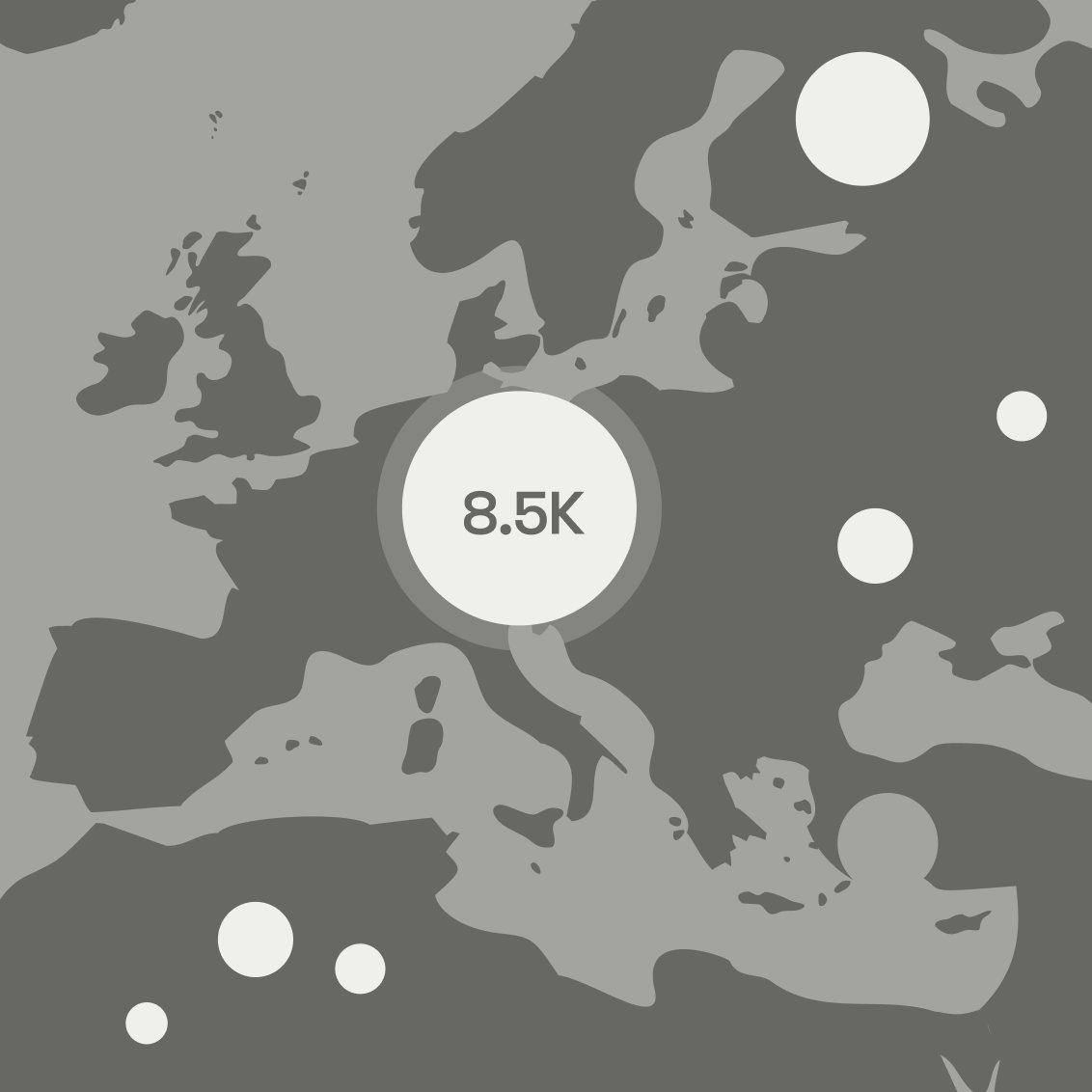The rise of measuring brand performance
Marketers are getting better and better at measuring the performance and impact of their work as analytics tools become more sophisticated and they have access to more data. The same is happening in branding. We’re seeing a cultural shift towards data-driven branding, where companies want to understand (and improve) the value of their brand.
This change toward analytics-based branding is driven by increased data availability and the fact that brands face more competition in the market than ever before. Search G2 for marketing automation software, for example, and you have almost 400 different products to choose from. It’s becoming harder for companies to compete based on features alone, so your brand is now a key differentiator.
But how can you know if your brand resonates with customers — and your internal audience? You need to measure your brand performance, and the starting point is analytics.
Understanding brand performance metrics and KPIs
If you’re investing heavily in your brand, you want to be sure that your investment’s paying off and that you’re building a high-performing brand by increasing brand recognition and awareness.
A top-performing brand has strong recognition in the market, achieved through high levels of consistency across visuals, messaging, and culture. A robust brand helps boost your brand equity — the value customers place on a business based on their perceptions of its quality.
But there’s still a lingering perception of “brand” as a soft, intangible project — a nice-to-have that doesn’t really drive any actual business value. Marketers and brand leaders can overcome that assumption by tracking core metrics and KPIs that demonstrate the tangible benefits of their brand.

The role of brand KPIs
Key performance indicators (KPIs) are measurable and quantifiable metrics that track your progress toward a specific goal or objective.
To fully understand your brand performance — and how it changes over time — you need a goal. And you need to set KPIs to monitor your progress and tweak your strategy. If you’re tracking brand performance, your goal might be a specific percentage of share of voice, brand awareness, or brand loyalty. This will help you demonstrate tangible brand growth and tie it back to the benefits and value for the organization.
In the next section, we’ll cover some key brand-related metrics you could track. Choose a handful that closely ties into your goals, and use those as the KPIs you measure your performance against.
Brand engagement
The level of interaction and engagement people have with your brand. Externally, this metric measures consumer engagement with your brand across different platforms, such as social media. Internal brand engagement monitors the level of engagement employees in different departments have with your brand.
Brand awareness
The percentage of people who recognize your brand. Awareness can be aided (for example, choosing from a list of named brands) or unaided (remembered without any prompts).
Brand preference
The degree to which consumers prefer your brand over your competitors.
Brand loyalty
How likely customers are to keep buying from your brand and choosing it over your competitors.
Share of voice
The percentage of all online or offline mentions (or advertising) that are about your brand compared to competitors.
Mentions and sentiment analysis
The number of mentions of your brand on social media, news, and other platforms and the sentiment (positive, negative, neutral) of those mentions. This metric tracks the percentage of positive or negative sentiment to measure the general perception of your brand and products.
Measuring brand performance across tools and channels
Now that you understand the metrics, let’s look at how your tools and channels make tracking brand performance easier.
Brand guidelines: More than just a rulebook
Your brand guidelines are more than just a set of instructions — they can be a source of valuable information to help increase consistency and the adoption of core assets.
However, just having guidelines does not necessarily improve brand performance. Understanding usage and adherence is also beneficial: Tracking guideline analytics data helps you understand brand adoption internally. Different departments and team members will be using your assets, and you want to be confident that all employees share the correct files to present a consistent brand identity outside the company.

If you use online brand guidelines like Frontify, you can access data that provides insights into brand guideline usage. For example, you can track how many people visit the guidelines on logo usage and whether they download a file from that page. Additionally, you can use this data to improve how people interact with your brand guidelines.
Here are some of the indicators that help you shape and refine your guidelines:
Low usage:
If people don’t use the guidelines, you can provide better or more frequent training to help people understand how to use your brand guidelines. You can ensure everyone in the organization — not just the marketing team — can access the guidelines, not just the marketing team
Spikes in visits:
If you see spikes in visits to specific sections or assets, you’ll know those are the most valuable brand materials for your internal stakeholders. Therefore, if you update anything on those pages, you can prioritize an internal education campaign to help people understand how the brand is evolving.
Guideline deviations:
Finally, you can track any inconsistencies in your brand. If you notice patterns where specific teams or team members struggle to follow your brand guidelines, you can check their guideline usage. Perhaps they don’t have permission to view them, or they haven’t accessed them in a long time.
Combining detailed brand guidelines and guideline usage data helps improve internal creative consistency, which in turn contributes to a high-performing brand.
Brand performance and digital asset management
Digital asset management (DAM) is an essential part of modern brand-building. In the past, brand teams used to be the gatekeepers, reviewing everything a company created before it got published or shared externally. But now, companies publish on so many channels, and more people than ever create content on behalf of the company.
So, brand departments can’t keep track of everything anymore. That’s where digital asset management comes in: A DAM solution provides companies with a centralized location to organize and share all their brand assets. Teams can collaborate and create new assets or use existing files from other departments.
Additionally, a DAM provides analytics data that can help you improve brand performance. You can view historical data on how often assets get used and by whom. This information gives brand managers a complete understanding of asset usage across the organization and allows them to streamline workflows:
- Improve access to digital asset management systems
- Enhance asset organization and metadata to simplify finding the correct files
- Determine bottlenecks or blockers that prevent teams from using brand assets effectively
- Identify your organization’s most-used or most valuable brand assets

-
Tracking brand performance across marketing content
To understand the full picture of how your content is performing, you’ll want to look at internal and external accomplishments. External brand performance is typically tracked using tools such as Google Analytics or social media monitoring apps.
But it’s harder to understand the internal performance of your marketing content. Analytics data from your DAM can help you track asset usage across the organization: You can see which marketing assets are being shared most often to get a new way to track content distribution beyond traditional analytics tools like Google.
Understanding how marketing assets are used internally can help you balance content creation and distribution. If you discover libraries of marketing assets that have never been used, you may want to focus more on using your existing files and campaigns than creating new ones.
You’ll also want to track brand consistency across your content marketing, especially if multiple people in your organization create content. Do this by spot-reviewing content from different team members every couple of months. Look for consistent messaging and visual presentation that aligns with your brand guidelines. This consistency helps increase brand recognition, which builds aided and unaided brand awareness — one of those crucial brand KPIs.
How brand performance drives budget decisions
If you can track and report on your brand’s performance, it’s easier to secure a budget for future investments in brand-related tools or projects.
For brand managers, it’s helpful to provide tangible data demonstrating your brand’s ROI to key stakeholders. Use the key metrics we mentioned earlier in this article: Start tracking them to measure your brand performance, and the value it’s bringing to your organization.
Measuring brand performance can also help you optimize your brand-related spend, so you’re investing in areas that need it most. For example, you can understand how global teams use brand assets and determine if you need to invest more in training materials or other resources in certain regions.
And if you’re looking to invest more in your existing brand setup — like increasing spend on your brand management solution — it’ll be helpful to explain the current usage and performance. This brings concrete data and quantifiable benefits into budget conversations to help make the case for further investment.
Improve performance by integrating software for seamless brand operations
Before improving your external brand performance, you first need to get it working well internally. That means engaging employees from all departments and achieving visual and messaging consistency across the organization.
To achieve these goals, you need to help people use the brand in their daily work. For example, sales teams share brand messaging that consistently reflects your core values. Marketing teams accurately represent the brand, even in their most creative campaigns. Even back-office teams like finance and IT know how to correctly use your logos, typography, and colors to present a professional brand image.

The right tools make it easy to improve internal brand performance. A brand management platform like Frontify provides a centralized home where all users can connect with the brand. It hosts your brand guidelines, DAM, and other resources that help improve collaboration, even for remote teams.
A brand platform should be your starting point for improving brand performance. You can then strengthen operations by integrating the platform with the other tools your teams use every day: Figma, Adobe, or Canva integrate with your brand platform, enabling designers to seamlessly find relevant, on-brand assets for their projects. Marketing tools like your CMS or content creation applications connect with your brand management platform so the team can find brand files quickly and easily.
Integrating your existing tech stack with a brand management platform helps fill the gaps in your team’s knowledge and workflows. If employees can access the correct logo file straight from the program they’re working in, they have no excuse for using outdated or incorrect brand assets.
If you can make brand operations seamless across departments and the organization, it becomes much easier to achieve a high level of internal brand performance and engagement.
The future of brand performance
Brand teams are getting better and better at measuring their brand’s performance. We know the value of a strong, consistent brand, and we’re increasingly doing a better job of communicating that value across the organization, particularly to leadership.
But up to now, most of our understanding of brand performance comes from historical data. Even though most of our understanding of brand performance comes from historical data, we're at the cusp of a new era: using data to forecast future outcomes.
The next step in mastering brand performance is to use that data to forecast future outcomes. If brand teams can harness the power of predictive analytics, they have the potential to identify new opportunities and improve brand operations across the business. You’ll be able to predict how guideline access will change across global teams, which can lead to a drop in brand consistency. To counter that, you’ll be able to proactively invest in training and resources to keep employees engaged and aligned with your brand.



